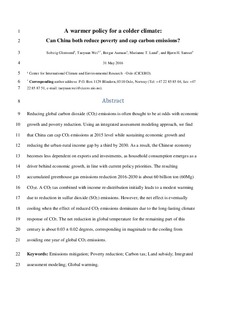| dc.contributor.author | Glomsrød, Solveig | |
| dc.contributor.author | Wei, Taoyuan | |
| dc.contributor.author | Aamaas, Borgar | |
| dc.contributor.author | Lund, Marianne Tronstad | |
| dc.contributor.author | Samset, Bjørn Hallvard | |
| dc.date.accessioned | 2017-11-10T12:49:54Z | |
| dc.date.available | 2017-11-10T12:49:54Z | |
| dc.date.created | 2016-12-02T11:25:27Z | |
| dc.date.issued | 2016 | |
| dc.identifier.citation | Science of the Total Environment. 2016, 568 236-244. | nb_NO |
| dc.identifier.issn | 0048-9697 | |
| dc.identifier.uri | http://hdl.handle.net/11250/2465561 | |
| dc.description | This is an accepted manuscript of an article published by Elsevier in Science of the Total Environment on 15 October 2016, available online: https://doi.org/10.1016/j.scitotenv.2016.06.005 | nb_NO |
| dc.description.abstract | Reducing global carbon dioxide (CO2) emissions is often thought to be at odds with economic growth and poverty reduction. Using an integrated assessment modeling approach, we find that China can cap CO2 emissions at 2015 level while sustaining economic growth and reducing the urban-rural income gap by a third by 2030. As a result, the Chinese economy becomes less dependent on exports and investments, as household consumption emerges as a driver behind economic growth, in line with current policy priorities. The resulting accumulated greenhouse gas emissions reduction 2016–2030 is about 60 billion ton (60 Mg) CO2e. A CO2 tax combined with income re-distribution initially leads to a modest warming due to reduction in sulfur dioxide (SO2) emissions. However, the net effect is eventually cooling when the effect of reduced CO2 emissions dominates due to the long-lasting climate response of CO2. The net reduction in global temperature for the remaining part of this century is about 0.03 ± 0.02 °C, corresponding in magnitude to the cooling from avoiding one year of global CO2 emissions. | nb_NO |
| dc.language.iso | eng | nb_NO |
| dc.title | A warmer policy for a colder climate: Can China both reduce poverty and cap carbon emissions? | nb_NO |
| dc.type | Journal article | nb_NO |
| dc.type | Peer reviewed | nb_NO |
| dc.description.version | submittedVersion | nb_NO |
| dc.source.pagenumber | 236-244 | nb_NO |
| dc.source.volume | 568 | nb_NO |
| dc.source.journal | Science of the Total Environment | nb_NO |
| dc.identifier.doi | 10.1016/j.scitotenv.2016.06.005 | |
| dc.identifier.cristin | 1407548 | |
| dc.relation.project | Norges forskningsråd: 209701 | nb_NO |
| dc.relation.project | Norges forskningsråd: 199491 | nb_NO |
| dc.relation.project | Norges forskningsråd: 244119 | nb_NO |
| cristin.unitcode | 7475,0,0,0 | |
| cristin.unitname | CICERO Senter for klimaforskning | |
| cristin.ispublished | true | |
| cristin.fulltext | preprint | |
| cristin.qualitycode | 2 | |
